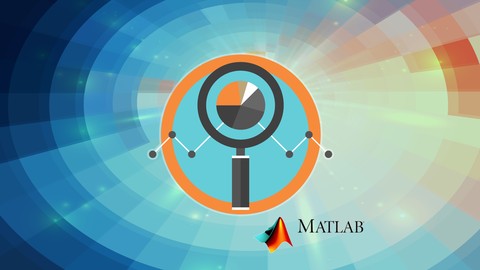
MATLAB for the Absolute Beginner
MATLAB for the Absolute Beginner, available at $19.99, has an average rating of 3.4, with 56 lectures, based on 128 reviews, and has 10590 subscribers.
You will learn about Navigate the MATLAB desktop environment Create and utilize matrices in MATLAB Work with Arrays in MATLAB Make an animation in MATLAB Make three-dimensional plots Create various graphs to visualize data Create and utilize tables Understand the basics of Simulink Understand simple GUIs in MATLAB This course is ideal for individuals who are This course is meant for student who have never used MATLAB It is particularly useful for This course is meant for student who have never used MATLAB.
Enroll now: MATLAB for the Absolute Beginner
Summary
Title: MATLAB for the Absolute Beginner
Price: $19.99
Average Rating: 3.4
Number of Lectures: 56
Number of Published Lectures: 56
Number of Curriculum Items: 56
Number of Published Curriculum Objects: 56
Original Price: $129.99
Quality Status: approved
Status: Live
What You Will Learn
- Navigate the MATLAB desktop environment
- Create and utilize matrices in MATLAB
- Work with Arrays in MATLAB
- Make an animation in MATLAB
- Make three-dimensional plots
- Create various graphs to visualize data
- Create and utilize tables
- Understand the basics of Simulink
- Understand simple GUIs in MATLAB
Who Should Attend
- This course is meant for student who have never used MATLAB
Target Audiences
- This course is meant for student who have never used MATLAB
If you want to learn how to use MATLAB, but have little to no experience, this course is for you! If you have some MATLAB experience, and want to learn more, this course may be for you too! Sign up now by clicking the enroll button.
In this course, you will learn:
Chapter 1: First Look
The video introduces the learner to the MATLAB desktop environment. At the end of this video, the learner will be able to identify and use
- Command Window
- Workspace
- Command History
- Current Folder
- Home tab
The learner will be able to create variables and perform simple mathematical operations on them.
Chapter 2: Introduction to matrices
This chapter is divided into 9 parts
- Part 1: This session demonstrates
- how to create matrices
- how to find its dimensions
- how to take the transpose of a matrix
- Part 2: The session demonstrates the use of indices to access a section of the matrix
- Part 3: The session demonstrates the addition and subtraction of matrices
- Part 4: This session demonstrates the multiplication operation on matrices
- Part 5, 6: These sessions demonstrate the use of matrices is solving a numerical problem
- Part 5: Example I
- Part 6: Example II
- Part 7,8,9:These sessions introduce the learner to black-and-white, gray-scale and colored images on MATLAB
Chapter 3: Working with arrays
This chapter is divided into 4 parts
- Part 1: This session introduces the learner to arrays on MATLAB, and some basic mathematical operations
- Part 2: This session takes an example of a quadratic expression, and how arrays can be used to evaluate it over a range of values
- Part 3: This session discusses how to generate a sequence of numbers on MATLAB
- Part 4: This session demonstrates common statistical computations on arrays like mean, median et cetera
Chapter 4: Make an animation
This chapter is divided into 7 parts.
- Part 1: This session introduces the learner to the Editor Window on MATLAB
- Part 2-7: These sessions develop the animation of a rotating fan step by step
- Part 2: Step 1
- Part 3: Step 2
- Part 4: Step 3
- Part 5: Step 4
- Part 6: Step 5
- Part 7: Step 6
Chapter 5: Three dimensional plots
This chapter is divided into 2 parts
- Part 1: This session discusses three dimensional line plots
- Part 2: This session discusses three dimensional surface plots
Chapter 6: Working with Data
This chapter has been divided into 8 parts.
- Part 1: This session is a recapitulation of the common statistical operations of mean, median et cetera
- Part 2: This session demonstrates how to make a simple bar graph/chart
- Part 3: This session demonstrates how to make a bar graph/chart with multiple bars grouped together
- Part 4: This session demonstrates how to make a pie chart
- Part 5: This session takes a line plot and adds title and labels to it, to enhance readability.
- Part 6: This session adds labels and enhances the readability of a pie chart.
- Part 7, 8: These sessions demonstrate how to create a function with looping and conditional statements
- Part 7: Example 1
- Part 8: Example 2
Chapter 7: Working with Tables
This chapter has been divided into 2 parts.
- Part 1: This session introduces the user to structures, demonstrates how to create tables using structures, and discusses an application where multiple tables are joined together
- Part 2: This session reads a file, convert the data into table and perform some operations on them
Chapter 8: Introduction to Simulink
This chapter has been divided into 7 parts
- Part 1: This shows how to open Simulink
- Part 2: This session demonstrates how to make a simple model on Simulink
- Part 3: This session demonstrates some common sources.
- Part 4: This session demonstrates blocks related to common mathematical operations.
- Part 5: This session demonstrates how Simulink can be used to model digital logic circuits.
- Part 6: This session demonstrates how to make a sub-module/subsystem/sub-circuit on Simulink
- Part 7: This session demonstrates how to make Simulink models for differential equations
Chapter 9: Simple Graphical User Interfaces
This chapter is divided into 5 parts.
- Part 1: This session demonstrates the input function in MATLAB
- Part 2-5: This session demonstrates simple GUIs on MATLAB
- Part 2: GUI 1
- Part 3: GUI 2
- Part 4: GUI 3
- Part 5: GUI 4
Chapter 10: Miscellaneous / Bonus Lectures
This chapter aims to give the learner ideas to create codes and block diagrams and thus practice MATLAB. This chapter has been divided into 10 parts
- Part 1: This session introduces the user to the Symbolic Math Toolbox
- Part 2: This session demonstrates how the functions in the Symbolic Math toolbox can be used to solve a numerical problem
- Part 3: This session demonstrates how to use Symbolic Math Toolbox to work with Laplace transforms and then moves to the Control System Toolbox.
- Part 4: This session is just the viewing of a paper from which Control System codes and block diagrams can be made.
- Part 5,6: These sessions introduce some basic functions in the Image Processing Toolbox.
- Part 5: Histogram Equalization
- Part 6: Gray-scale conversion, Morphological operations, et cetera
- Part 7: This session takes an example and demonstrates recursive functions on MATLAB
- Part 8: This session is just the viewing of a paper from which Simulink models relevant to Digital Signal Processing can be made.
- Part 9: This session is just the viewing of a document on sequences and progressions, which can be used to create iterative and recursive functions on MATLAB.
- Part 10: This session shows a Graphical User Interface which the learner can try to create using concepts on image processing.
Course Curriculum
Chapter 1: Welcome to MATLAB for the absolute beginner!
Lecture 1: Introduction and Overview of Course
Chapter 2: First Look at MATLAB
Lecture 1: First Look at MATLAB
Chapter 3: Introduction to Matrices
Lecture 1: Matrices: Part 1
Lecture 2: Matrices: Part 2
Lecture 3: Matrices: Part 3
Lecture 4: Matrices: Part 4
Lecture 5: Matrices: Part 5
Lecture 6: Matrices: Part 6
Lecture 7: Matrices: Part 7
Lecture 8: Matrices: Part 8
Lecture 9: Matrices: Part 9
Chapter 4: Working With Arrays
Lecture 1: Arrays: Part 1
Lecture 2: Arrays: Part 2
Lecture 3: Arrays: Part 3
Lecture 4: Arrays: Part 4
Chapter 5: Make an Animation in MATLAB
Lecture 1: Animation: Part 1
Lecture 2: Animation: Part 2
Lecture 3: Animation: Part 3
Lecture 4: Animation: Part 4
Lecture 5: Animation: Part 5
Lecture 6: Animation: Part 6
Lecture 7: Animation: Part 7
Chapter 6: Three Dimensional Plots in MATLAB
Lecture 1: 3D Plots: Part 1
Lecture 2: 3D Plots: Part 2
Chapter 7: Working with Data and Graphs in MATLAB
Lecture 1: Data & Graphs: Part 1
Lecture 2: Data & Graphs: Part 2
Lecture 3: Data & Graphs: Part 3
Lecture 4: Data & Graphs: Part 4
Lecture 5: Data & Graphs: Part 5
Lecture 6: Data & Graphs: Part 6
Lecture 7: Data & Graphs: Part 7
Lecture 8: Data & Graphs: Part 8
Chapter 8: Working with Tables in MATLAB
Lecture 1: Tables: Part 1
Lecture 2: Tables: Part 2
Chapter 9: Introduction to Simulink
Lecture 1: Simulink: Part 1
Lecture 2: Simulink: Part 2
Lecture 3: Simulink: Part 3
Lecture 4: Simulink: Part 4
Lecture 5: Simulink: Part 5
Lecture 6: Simulink: Part 6
Lecture 7: Simulink: Part 7
Chapter 10: Simple Graphical User Interfaces(GUI) in MATLAB
Lecture 1: GUIs: Part 1
Lecture 2: GUIs: Part 2
Lecture 3: GUIs: Part 3
Lecture 4: GUIs: Part 4
Lecture 5: GUIs: Part 5
Chapter 11: Miscellaneous / Bonus MATLAB Lectures
Lecture 1: Symbolic Math Toolbox: Part 1
Lecture 2: Symbolic Math Toolbox: Part 2
Lecture 3: Symbolic Math Toolbox: Part 3
Lecture 4: Control System Codes & Block Diagrams
Lecture 5: Image Processing Toolbox: Part 1
Lecture 6: Image Processing Toolbox: Part 2
Lecture 7: Recursive Function in MATLAB
Lecture 8: Digital Signal Processing
Lecture 9: Iterative and Recursive Functions in MATLAB
Lecture 10: GUI with Image Processing Concepts
Instructors
Rating Distribution
- 1 stars: 9 votes
- 2 stars: 13 votes
- 3 stars: 25 votes
- 4 stars: 45 votes
- 5 stars: 36 votes
Frequently Asked Questions
How long do I have access to the course materials?
You can view and review the lecture materials indefinitely, like an on-demand channel.
Can I take my courses with me wherever I go?
Definitely! If you have an internet connection, courses on Udemy are available on any device at any time. If you don’t have an internet connection, some instructors also let their students download course lectures. That’s up to the instructor though, so make sure you get on their good side!
You may also like
- Top 10 Financial Technology Courses to Learn in December 2024
- Top 10 Agile Methodologies Courses to Learn in December 2024
- Top 10 Project Management Courses to Learn in December 2024
- Top 10 Leadership Skills Courses to Learn in December 2024
- Top 10 Public Speaking Courses to Learn in December 2024
- Top 10 Affiliate Marketing Courses to Learn in December 2024
- Top 10 Email Marketing Courses to Learn in December 2024
- Top 10 Social Media Management Courses to Learn in December 2024
- Top 10 SEO Optimization Courses to Learn in December 2024
- Top 10 Content Creation Courses to Learn in December 2024
- Top 10 Game Development Courses to Learn in December 2024
- Top 10 Software Testing Courses to Learn in December 2024
- Top 10 Big Data Courses to Learn in December 2024
- Top 10 Internet Of Things Courses to Learn in December 2024
- Top 10 Quantum Computing Courses to Learn in December 2024
- Top 10 Cloud Computing Courses to Learn in December 2024
- Top 10 3d Modeling Courses to Learn in December 2024
- Top 10 Mobile App Development Courses to Learn in December 2024
- Top 10 Graphic Design Courses to Learn in December 2024
- Top 10 Videography Courses to Learn in December 2024






















